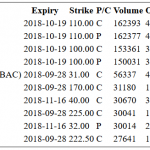Retail sales have been a disappointment now for three consecutive months and as such this may lead to downward revisions for Q2 GDP estimates. While that remains to be seen, something simply isn’t resonating well with the consumer. Maybe it’s uncertainty surrounding the future of healthcare, maybe it’s simply the every rising costs of healthcare premiums that are syphoning off retail sales, only time will tell. One thing is for certain though, absent April’s surge in retail sales and for much of 2017, retail sales have been slightly lower. And not all retail sales categories are created equally. The table below comes to us from the Census Bureau and recognizes that retail sales fell in the month of June by .2% against an expectation for an increase of .2 percent. This comes on the heels of May retail sales, which also fell .1 percent.

The usual culprits showing the largest retail sales declines were grocery stores, miscellaneous stores and department stores. And it’s in that regard that we further discuss and analyze the department store names. Most department store stocks such as J.C. Penny (JCP), Target (TGT), Kohl’s (KSS ), Macy’s (M) and even Wal-Mart (WMT) have all had a rough go of it in 2017.
Every year I offer a full-scale retail industry report. In 2016 this report was some 35 pages of content on the retail industry, consumption trends, and specific retail brand forecasts. Last year’s report was purchased by roughly 400 funds and portfolio managers. Famed asset manager Alan Valdez on Yahoo Finance shared the sentiment and warnings within the report publicly in October of 2016. The basic tenor of the report warned of a pending calamity in the retail industry that would find significant store consolidation and lesser same-store-sales. Some of my more targeted individual brand warnings were heralded for J.C. Penney, Target, Macy’s and Bed Bath & Beyond.
What the team at focusedstocktrader.com and I are concerned about is the downward trend in retail sales. My colleague Seth Golden notes in his institutional report that, besides the April 1.2% outlier, sales have been anything but inspiring.
September retail sales came in at a lackluster -0.3% month-to-month. And look no further than today’s guidance from Wal-Mart (WMT), projecting a lackluster profit outlook into 2018. Even more troubling is the amount of big box stores closing hundreds of locations: Macy’s (M), Kmart, Sears (SHLD), and Wal-Mart. Yes, people are using online shopping more and more, but the closing of so many stores tells us the consumer is starting to have a more difficult time—and maybe the jobs number Wall Street looks at is not showing us the real picture of Main Street.”
Wal-Mart reported the best Q1 2017 results of the bunch for which the stock surged immediately after reporting, but has since given up most every bit of those gains. Target beat expectations during Q1, but even so the commentary from management surrounding the quarter’s results was subdued and cautious. Guidance wasn’t revised higher, even though I believed it should have been. More importantly and somewhat hidden in Target’s Q1 results was a dramatic 5% reduction in inventory. This helped the retailer greatly with regards to expenses and beating bottom line expectations. Investors aren’t as easily fooled as they may have been in the past. J.C. Penney had similar results as the firm beat bottom line expectations mightily. However, the bottom line beat was mainly attached to asset sales that can’t be duplicated and actually set a high bar for the company to jump over in the following year. More importantly, J.C. Penney’s same-store-sales fell much more than expected, by 3.5% YOY. This result damaged the total investor sentiment regarding J.C. Penney’s Q1 results. Moreover, the SSS decline was the largest in more than 10 quarters.
Department stores are and will likely continue to struggle for years to come. The seismic shift in retail online demand is unlikely to reverse course. Even with these traditional department store brands spending billions for omni-channel, retail sales platforms, the return on investment is slow to come. It may take many more years and further retail brick and mortar consolidation before an equilibrium can be found for some of these department store brands. What is more likely to occur for the likes of J.C. Penney, Target, Kohl’s, Macy’s Wal-Mart and the like are periods of stabilization followed by periods of declines.Simply put, one bad year will lead to better results in the following year provided by low expectations and low metric results in the previous year. Some of that forecast is already being realized here in late 2017.














Leave A Comment